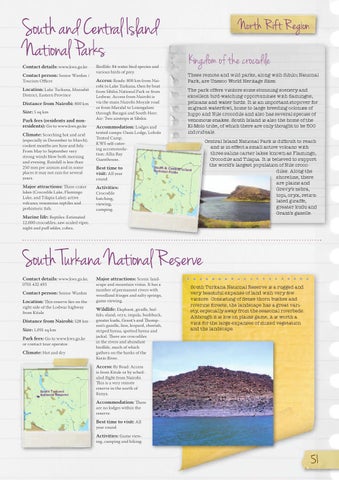South and Central Island National Parks Contact details: www.kws.go.ke
Contact person: Senior Warden / Tourism Officer
Location: Lake Turkana, Marsabit District, Eastern Province
Distance from Nairobi: 800 km Size: 5 sq km Park fees (residents and nonresidents): Go to www.kws.go.ke Climate: Scorching hot and arid
Birdlife: 84 water bird species and various birds of prey.
Access: Roads: 800 km from Nai-
robi to Lake Turkana, then by boat from Sibiloi National Park or from Lodwar. Access from Nairobi is via the main Nairobi-Moyale road or from Maralal to Loiengalani through Baragoi and South Horr. Air: Two airstrips at Sibiloi.
Accommodation: Lodges and tented camps: Oasis Lodge, Lobolo Tented Camp. KWS self-catering accommodation: Allia Bay Guesthouse.
(especially in December to March); coolest months are June and July. From May to September very strong winds blow both morning and evening. Rainfall is less than 250 mm per annum and in some places it may not rain for several years.
round
Major attractions: Three crater
Activities:
lakes (Crocodile Lake, Flamingo Lake, and Tilapia Lake); active volcano; venomous reptiles and prehistoric fish.
North Rift Region Kingdom of the crocodile These remote and wild parks, along with Sibiloi National Park, are Unesco World Heritage Sites. The park offers visitors some stunning scenery and excellent bird-watching opportunities with flamingos, pelicans and water birds. It is an important stopover for migrant waterfowl, home to large breeding colonies of hippo and Nile crocodile and also has several species of venomous snakes. South Island is also the home of the El-Molo tribe, of which there are only thought to be 500 individuals. Central Island National Park is difficult to reach and is in effect a small active volcano with three saline carter lakes known as Flamingo, Crocodile and Tilapia. It is believed to support the world’s largest population of Nile crocodiles. Along the shoreline, there are plains and Grevy’s zebra, topi, oryx, reticulated giraffe, greater kudu and Grant’s gazelle.
Best time to visit: All year Crocodile hatching, viewing, camping.
Marine life: Reptiles: Estimated
12,000 crocodiles, saw-scaled viper, night and puff adder, cobra.
South Turkana National Reserve Contact details: www.kws.go.ke,
0701 432 493
Contact person: Senior Warden Location: This reserve lies on the right side of the Lodwar highway from Kitale Distance from Nairobi: 528 km Size: 1,091 sq km Park fees: Go to www.kws.go.ke or contact tour operator. Climate: Hot and dry
Major attractions: Scenic landscape and mountain vistas. It has a number of permanent rivers with woodland fringes and salty springs, game viewing. Wildlife: Elephant, giraffe, buf-
falo, eland, oryx, impala, bushbuck, greater kudu, Grant’s and Thompson’s gazelle, lion, leopard, cheetah, striped hyena, spotted hyena and jackal. There are crocodiles in the rivers and abundant birdlife, much of which gathers on the banks of the Kerio River.
South Turkana National Reserve is a rugged and very beautiful expanse of land with very few visitors. Consisting of dense thorn bushes and riverine forests, the landscape has a great variety, especially away from the seasonal riverbeds. Although it is low on plains game, it is worth a visit for the large expanses of mixed vegetation and the landscape.
Access: By Road: Access is from Kitale or by scheduled flight from Nairobi. This is a very remote reserve in the north of Kenya. Accommodation: There are no lodges within the reserve. Best time to visit: All year round
Activities: Game view-
ing, camping and hiking.
51
